

Taiyo Kogyo Column
Shelters that Repel Sunlight and Mitigate the Heat Island Effect
2020.07.07
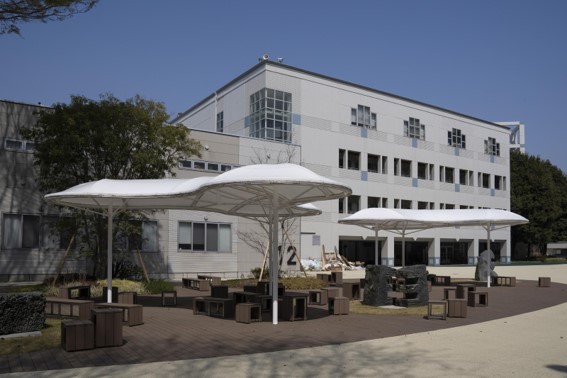
まもなく夏本番。6月時点で35度以上の猛暑日を記録するなど今年も暑い夏が予想されます。近年、ヒートアイランド現象の影響による都市部の気温上昇は顕著で、東京では過去100年間で平均気温は3.3℃上昇、全国平均1.5℃を大きく上回っています。要因としてあげられるのが、アスファルトなどによる「地表面被覆の人工化」、エアコンなどの「人工排熱の増加」、そして「都市形態の高密度化」です。
そんな都市部の暑さ対策に有用とされているのが、街中に木陰で休める<クールスポット>を設けることです。自然の木陰があればいいのですが、都市部ではなかなか難しいため、近年、注目を集めているのが日射反射率が高い白色の酸化チタン光触媒膜を用いたシェルターの活用です。駅舎プラットフォームの屋根、駅前広場、公園、商業施設の屋外広場に膜を用いたシェルターを設置する。それだけで温熱環境は大きく改善。熱中症予防はもちろんのこと、空間の快適性を大きく向上させ、人々の賑わいを生むなど、場の付加価値を向上させ、地域の活性化にも寄与します。
Mechanism of heat felt by humans
Why is the shade of a tree more comfortable even if the temperature is the same?
夏の暑さで注意しなくてはいけないのが熱中症です。気温が25℃以上になると警戒が必要とされ、28℃〜31℃で厳重警戒、31℃以上になると危険とされ高齢者は安静状態でも発生する危険性が高いといわれます。近年、救急搬送者数は上昇傾向にあり、2018年夏場(5−9月)には9万5000人にも達しました。
この暑さという点で着目しなくてはいけないのが実際の気温だけでなく、人が「暑い」と感じる体感温度です。体感温度は気温にくわえ、湿度、風の強さ、路面からの放出熱に大きく影響されます。なかでも路面からの放出熱は赤外放射と呼ばれ、表面温度に応じて電磁波として放出され、温度が高いほど放射量は強くなります。夏の暑い日、黒いアスファルトのような場合には表面温度が60℃を超えることもあり、環境省の調査によれば、夏場、歩行者が受ける熱量が最も大きい場所では、6畳部屋で1000ワットの電気ストーブを10台使用したのと同程度の暑さになるといいます。
木陰が日向に比べて涼しいと感じるのは気温が低いからだと思われがちですが、実際には同じ気温でも日射や路面からの赤外放射が少ないために涼しいと感じるのです。つまり都市部の暑さ対策にとって重要なのは、単に日差しを遮るのではなく、より効果的に日射や地表からの赤外放射を抑制することです。光を遮るために屋根を設けたとしても、反射率が低く熱を溜め込んでしまったなら屋根の表面温度は上がり、体感温度の改善にはつながりません。見た目の明るさ、暗さではなく、いかに効果的に日射を反射させ、表面温度が上昇しない素材を選ぶか。それが都市のクールスポットをつくる重要なポイントとなります。
Why light-permeable membrane materials are cooler
Compared to common materials such as metal and slate, membrane roofs are often thought to increase the temperature of the space under the roof due to their high light transmission rate. However, Taiyo Kogyo’s photocatalytic membrane material (white) has a high solar reflectance of approximately 80%, which means that it absorbs very little heat from the roof itself, resulting in a lower attic temperature of 9°C compared to a metal roof. This low heat absorption rate has a significant effect on the temperature under the roof, and measurements of the temperature environment on a platform roof in summer have shown that the temperature felt at 1.2m above the floor is 1.5°C lower on a membrane roof than on a metal roof, and the average radiant temperature is 3°C lower. In addition, the maximum illumination was 16,000 lx, much higher than that of metal or slate, indicating that the membrane roof provides a brighter and cooler environment than other materials.
Comfortable space created by a membrane roof that is overwhelmingly cooler and brighter than metal or slate.
● Membrane roof
Air temperature: 35°C / Attic surface temperature: 40°C Mean radiant temperature (MRT): 37°C / Body temperature (action temperature OT): 36°C
Maximum illumination: 16,000lx


Metal roofing
Air temperature: 35°C / Attic surface temperature: 49°C Mean radiant temperature (MRT): 40°C / Body temperature (action temperature OT): 37.5°C
Maximum illumination: 4,700lx


Slate roof
Air temperature: 37°C / Attic surface temperature: 55°C Mean radiant temperature (MRT): 42°C Body temperature (action temperature OT): 39.5°C
Maximum illumination: 2,400 lx
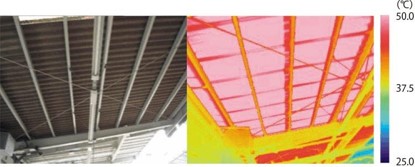
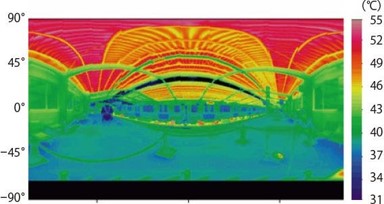
Photocatalytic membrane that allows light to pass through but not heat
This is a comparison of the solar radiation characteristics of white and gray membrane materials. The white color has higher solar reflectance and lower heat absorption than the gray, indicating that the surface temperature of the membrane is less likely to rise.

The figure shows the solar radiation reflection characteristics by wavelength for the white photocatalytic tent and three other colored membrane materials. The white photocatalytic tent shows a high reflectance of about 80% in almost all regions, while the reflectance of the normal tent (ivory) decreases in the near-infrared region. When the tent is soiled over time (gray color), the reflectance is reduced by half compared to the white color. Taiyo Kogyo’s photocatalytic membrane, which itself has an antifouling effect, is also superior in terms of solar reflectance.
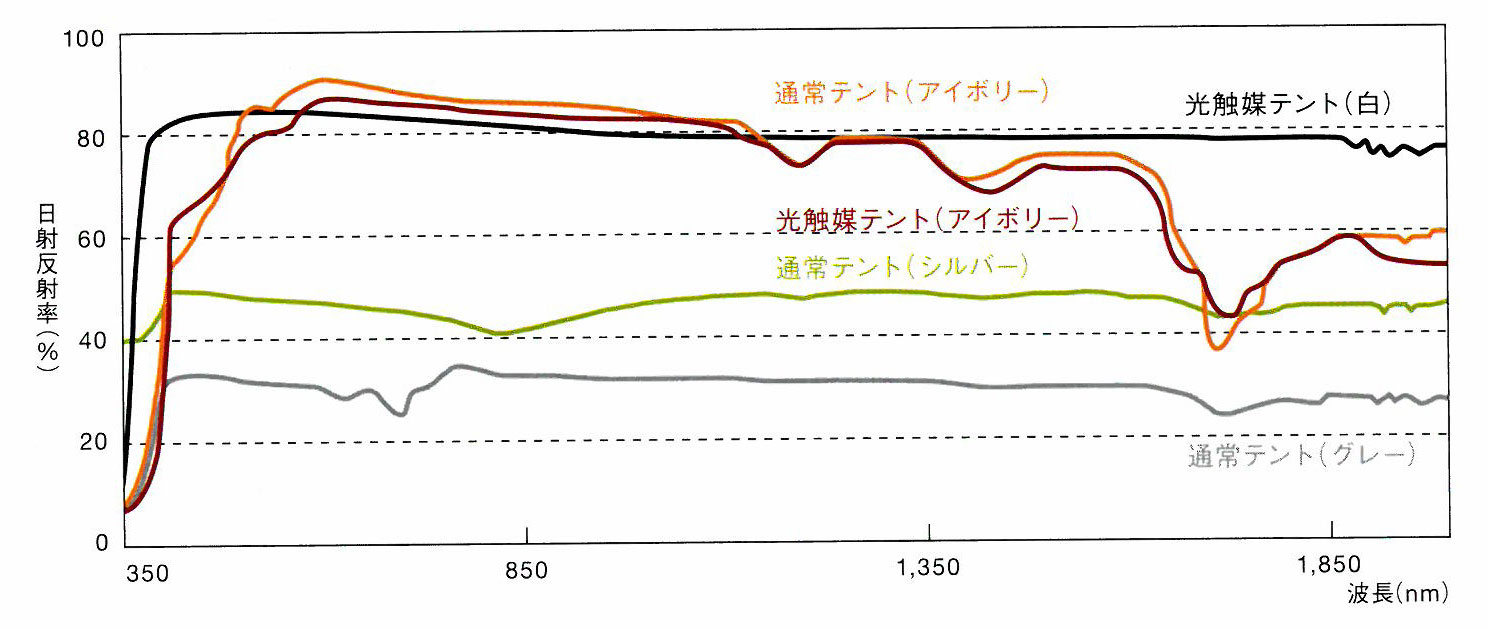
●熱反射率が高い
白色の光触媒膜は日射を約80%も跳ね返し。光を透光させて明るさを確保しつつ快適な日陰空間をつくりだせます。
●防除性能で汚れに強い
光触媒膜は汚れを化学的に分解除去する酸化チタン光触媒の粒子が膜材と一体化。そのセルフクリーニング機能によって、膜のくすみや汚れを防ぎ、長期間にわたって性能を維持します。
●周囲の空気をきれいに
光触媒膜は排ガスに含まれる窒素酸化物(NOx)を除去する機能があるため、緑化などと同様に周囲の大気浄化効果も期待できます。また紫外線除去機能(UVカット機能)も備えており、透過する光の約95%の紫外線をカットします。

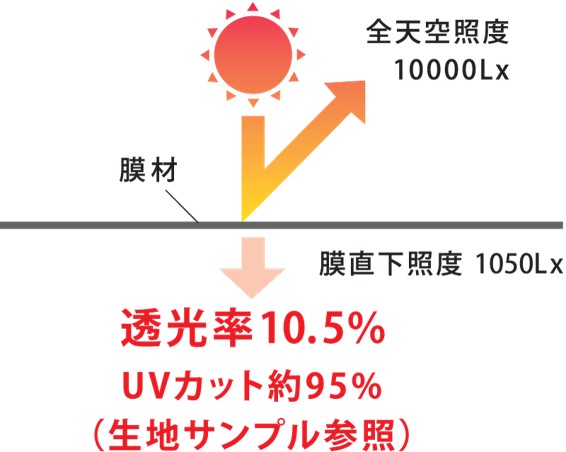
Urban cool spot created by membrane + water
Taiyo Kogyo’s photocatalytic membrane shelters prevent a rapid rise in temperature on the surface of the membrane due to its high solar reflectance, creating a space that is both bright and comfortable. While this basic performance alone is effective as a countermeasure against summer heat, by utilizing the hydrophilic properties of the membrane, the shelter itself can also actively control the temperature of the space by demonstrating the transpiration effect function of plants, rather than passively suppressing solar radiation.

Replicate the transpiration effect of plants by sprinkling and misting
都市部のヒートアイランド現象の抑制として効果が高い方法のひとつに壁面や屋上の緑化があります。これは日射量を抑えるだけでなく、植物が持つ蒸散効果によって熱を気化させることによる冷却効果が期待できるからです。一方で緑化はイニシャルコストやメンテナンスコストの負担、条件によっては設営できないなどの問題から導入が難しいという問題もあります。
その解決策として太陽工業が提案するのが超親水性の膜屋根に打ち水をし、水の蒸発冷却効果を利用するという手法です。酸化チタン膜材料は通常の膜材料と異なり、高い親水性を持っていることから表面に水が薄く広がります。これによって水の蒸発潜熱が熱交換の役割を果たし膜下の熱を奪い、くわえて周辺の大気熱も下げる空間温度を低下させる効果を発揮します。
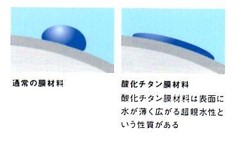
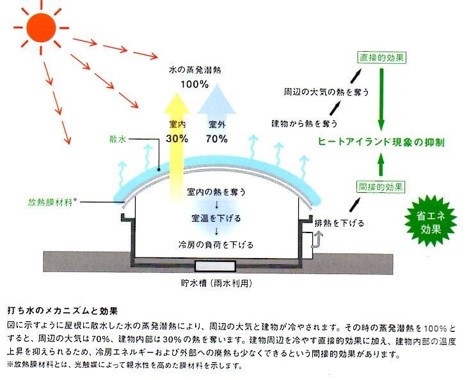
Mist shelters, in which a mist spray device is installed in the shelter to control the space temperature using the vaporization heat effect, are also attracting attention. The mist sprayed from the nozzle has fine particles, so there is no discomfort when it touches the skin, and the tent’s thermal barrier effect and the mist can lower the temperature under the membrane roof by -4 to 6°C. For example, if the amount of mist is controlled to match the amount of camphor trees that evaporate in mid-summer, the effect is equivalent to planting a camphor tree forest in an urban area. Compared to greening, maintenance is easier, and this technology is being increasingly adopted in commercial facilities and public spaces.


●気化熱効果
空気中に噴霧したミストの気化熱によって気温が下がり涼しい環境をつくりだします。
●低エネルギー
エアコンに比べて消費電力が少なくランニングコストも低く抑えられます。
●不快感がない
噴霧されるミストはきわめて微細なため、肌や服に触れても濡れることがなく、不快なベタつきやジメジメを感じることはありません。
Examples of shelters that are the face of the city
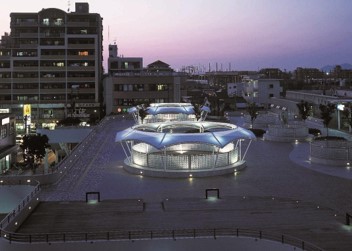
While functionality is of course important in creating a comfortable space by blocking out sunlight and rain, Taiyo Kogyo also considers how its products can match the landscape of the city. The beauty of the landscape has always been an important aspect of our product development. The same is true for shelters. In particular, shelters are installed in station plazas, parks, outdoor spaces of commercial facilities, and other places that should be considered the face of the city and its facilities, so we believe that how well they fit in with the space is another function of design.
Various designs for use in a variety of situations
◾Design variations

Simple structure supported by a single prop. For bench space in parks and commercial facilities.
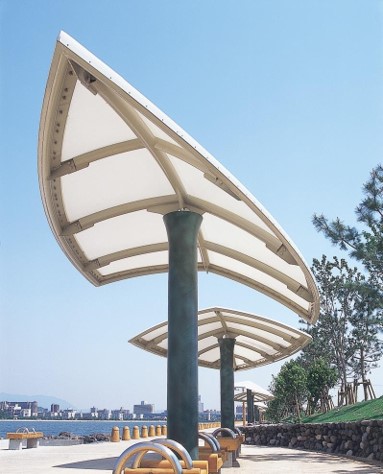
A combination of units allows for a variety of expressions to suit the location.

Variety of designs to choose from to suit the surrounding environment.
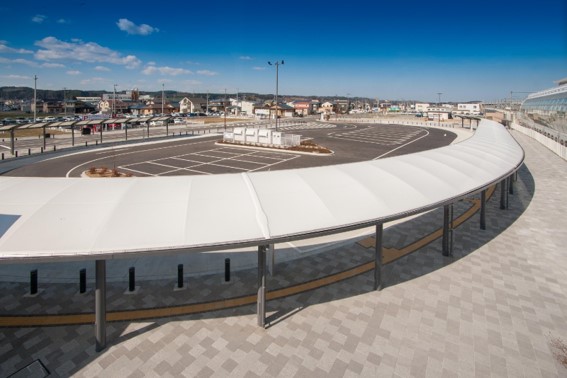
Parks, events, and disaster preparedness centers in town.
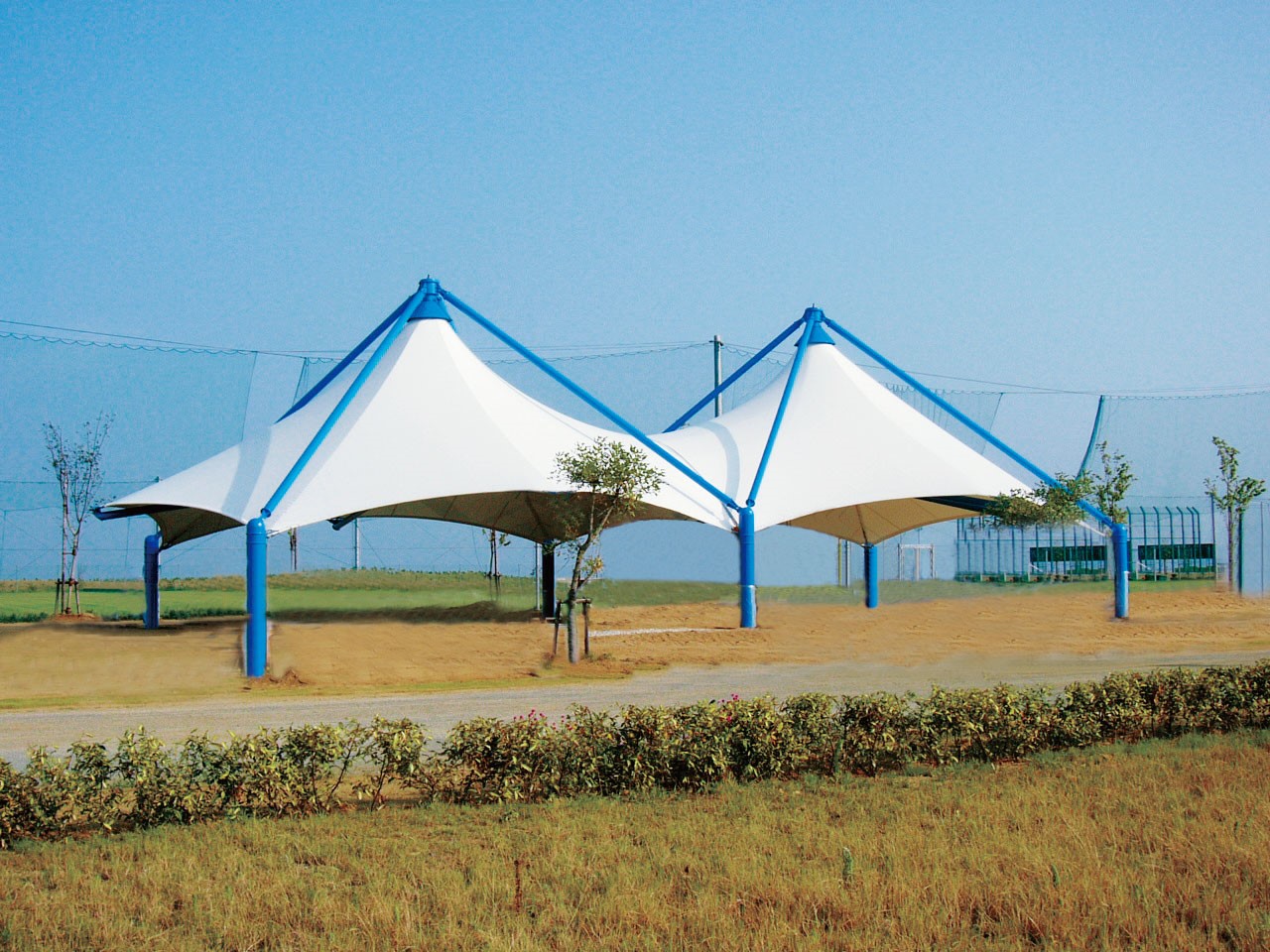
summary
Various designs are possible through combinations
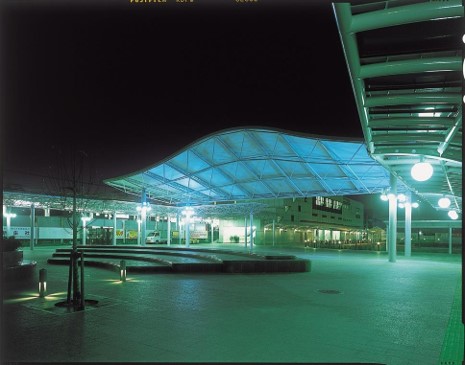
In addition to the aforementioned planned products, Taiyo Kogyo will respond to all the needs of our customers, including the development of original designs. We will contribute to the creation of livable cities by enhancing the comfort and beauty of station fronts, parks, plazas, and facilities with the excellent functionality and design of our shelters.
Click here for inquiries about System Shelter
●熱反射率が高い
白色の光触媒膜は日射を約80%も跳ね返し。光を透光させて明るさを確保しつつ快適な日陰空間をつくりだせます。
●防除性能で汚れに強い
光触媒膜は汚れを化学的に分解除去する酸化チタン光触媒の粒子が膜材と一体化。そのセルフクリーニング機能によって、膜のくすみや汚れを防ぎ、長期間にわたって性能を維持します。
●周囲の空気をきれいに
光触媒膜は排ガスに含まれる窒素酸化物(NOx)を除去する機能があるため、緑化などと同様に周囲の大気浄化効果も期待できます。また紫外線除去機能(UVカット機能)も備えており、透過する光の約95%の紫外線をカットします。


Urban cool spot created by membrane + water
Taiyo Kogyo’s photocatalytic membrane shelters prevent a rapid rise in temperature on the surface of the membrane due to its high solar reflectance, creating a space that is both bright and comfortable. While this basic performance alone is effective as a countermeasure against summer heat, by utilizing the hydrophilic properties of the membrane, the shelter itself can also actively control the temperature of the space by demonstrating the transpiration effect function of plants, rather than passively suppressing solar radiation.

Replicate the transpiration effect of plants by sprinkling and misting
都市部のヒートアイランド現象の抑制として効果が高い方法のひとつに壁面や屋上の緑化があります。これは日射量を抑えるだけでなく、植物が持つ蒸散効果によって熱を気化させることによる冷却効果が期待できるからです。一方で緑化はイニシャルコストやメンテナンスコストの負担、条件によっては設営できないなどの問題から導入が難しいという問題もあります。
その解決策として太陽工業が提案するのが超親水性の膜屋根に打ち水をし、水の蒸発冷却効果を利用するという手法です。酸化チタン膜材料は通常の膜材料と異なり、高い親水性を持っていることから表面に水が薄く広がります。これによって水の蒸発潜熱が熱交換の役割を果たし膜下の熱を奪い、くわえて周辺の大気熱も下げる空間温度を低下させる効果を発揮します。


Mist shelters, in which a mist spray device is installed in the shelter to control the space temperature using the vaporization heat effect, are also attracting attention. The mist sprayed from the nozzle has fine particles, so there is no discomfort when it touches the skin, and the tent’s thermal barrier effect and the mist can lower the temperature under the membrane roof by -4 to 6°C. For example, if the amount of mist is controlled to match the amount of camphor trees that evaporate in mid-summer, the effect is equivalent to planting a camphor tree forest in an urban area. Compared to greening, maintenance is easier, and this technology is being increasingly adopted in commercial facilities and public spaces.


●気化熱効果
空気中に噴霧したミストの気化熱によって気温が下がり涼しい環境をつくりだします。
●低エネルギー
エアコンに比べて消費電力が少なくランニングコストも低く抑えられます。
●不快感がない
噴霧されるミストはきわめて微細なため、肌や服に触れても濡れることがなく、不快なベタつきやジメジメを感じることはありません。
Examples of shelters that are the face of the city

While functionality is of course important in creating a comfortable space by blocking out sunlight and rain, Taiyo Kogyo also considers how its products can match the landscape of the city. The beauty of the landscape has always been an important aspect of our product development. The same is true for shelters. In particular, shelters are installed in station plazas, parks, outdoor spaces of commercial facilities, and other places that should be considered the face of the city and its facilities, so we believe that how well they fit in with the space is another function of design.
Various designs for use in a variety of situations
◾Design variations

Simple structure supported by a single prop. For bench space in parks and commercial facilities.

A combination of units allows for a variety of expressions to suit the location.

Variety of designs to choose from to suit the surrounding environment.

Parks, events, and disaster preparedness centers in town.

summary
Various designs are possible through combinations

In addition to the aforementioned planned products, Taiyo Kogyo will respond to all the needs of our customers, including the development of original designs. We will contribute to the creation of livable cities by enhancing the comfort and beauty of station fronts, parks, plazas, and facilities with the excellent functionality and design of our shelters.
Click here for inquiries about System Shelter
●気化熱効果
空気中に噴霧したミストの気化熱によって気温が下がり涼しい環境をつくりだします。
●低エネルギー
エアコンに比べて消費電力が少なくランニングコストも低く抑えられます。
●不快感がない
噴霧されるミストはきわめて微細なため、肌や服に触れても濡れることがなく、不快なベタつきやジメジメを感じることはありません。
Examples of shelters that are the face of the city

While functionality is of course important in creating a comfortable space by blocking out sunlight and rain, Taiyo Kogyo also considers how its products can match the landscape of the city. The beauty of the landscape has always been an important aspect of our product development. The same is true for shelters. In particular, shelters are installed in station plazas, parks, outdoor spaces of commercial facilities, and other places that should be considered the face of the city and its facilities, so we believe that how well they fit in with the space is another function of design.
Various designs for use in a variety of situations
◾Design variations

Simple structure supported by a single prop. For bench space in parks and commercial facilities.

A combination of units allows for a variety of expressions to suit the location.

Variety of designs to choose from to suit the surrounding environment.

Parks, events, and disaster preparedness centers in town.

summary
Various designs are possible through combinations

In addition to the aforementioned planned products, Taiyo Kogyo will respond to all the needs of our customers, including the development of original designs. We will contribute to the creation of livable cities by enhancing the comfort and beauty of station fronts, parks, plazas, and facilities with the excellent functionality and design of our shelters.
Click here for inquiries about System Shelter
A combination of units allows for a variety of expressions to suit the location.

Variety of designs to choose from to suit the surrounding environment.

Parks, events, and disaster preparedness centers in town.

summary
Various designs are possible through combinations

In addition to the aforementioned planned products, Taiyo Kogyo will respond to all the needs of our customers, including the development of original designs. We will contribute to the creation of livable cities by enhancing the comfort and beauty of station fronts, parks, plazas, and facilities with the excellent functionality and design of our shelters.
Click here for inquiries about System Shelter
Variety of designs to choose from to suit the surrounding environment.

Parks, events, and disaster preparedness centers in town.

summary
Various designs are possible through combinations

In addition to the aforementioned planned products, Taiyo Kogyo will respond to all the needs of our customers, including the development of original designs. We will contribute to the creation of livable cities by enhancing the comfort and beauty of station fronts, parks, plazas, and facilities with the excellent functionality and design of our shelters.
Click here for inquiries about System Shelter
Parks, events, and disaster preparedness centers in town.

summary
Various designs are possible through combinations

In addition to the aforementioned planned products, Taiyo Kogyo will respond to all the needs of our customers, including the development of original designs. We will contribute to the creation of livable cities by enhancing the comfort and beauty of station fronts, parks, plazas, and facilities with the excellent functionality and design of our shelters.
Click here for inquiries about System Shelter
Related Articles
- TOP>
- Taiyo Kogyo Column>
- Shelters that Repel Sunlight and Mitigate the Heat Island Effect








